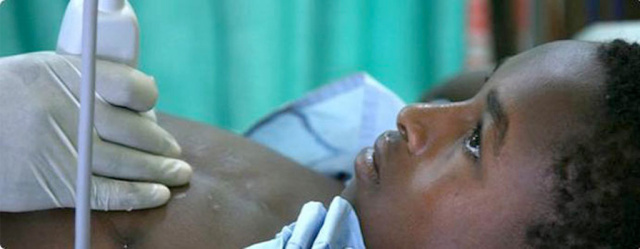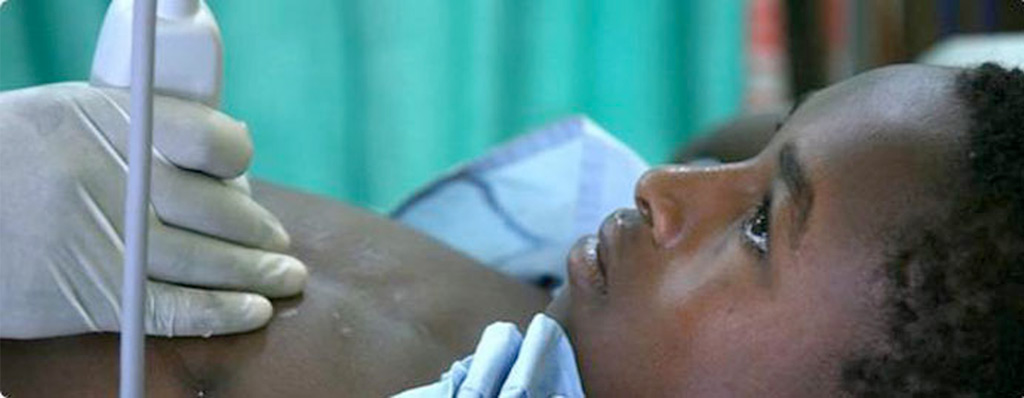

Ultrasound, CT scanners, and X-ray machines are medical technologies we generally take for granted. But in resource-limited areas around the world, access to these life-saving devices is severely limited. In a September 2017 feature in The Atlantic, medical writer Jason Silverstein described the challenges developing countries face without the benefit of point-of-care ultrasound devices, X-ray machines, and CT scanners.
Silverstein illustrated the stunning contrast between developing countries and one American city. Boston’s Massachusetts General Hospital alone has 126 radiologists1, while the entire nation of Kenya, a country of 43 million people, only has 200 radiologists2. In rural Nepal, people face a two-day trip and spending a month’s income to access X-ray or ultrasound machines.5 To make matters worse, more than 40% of ultrasound machines in developing countries are not fully functional3. And even where there is a scanning machine available, many areas lack qualified staff to run the machines.
The World Health Organization estimates two-thirds of the world do not have access to simple X-rays or ultrasound.4 Even if such technologies are available, they are often cost-prohibitive and inaccessible. In Nairobi, Kenya, a local hospital caring for the residents in the Kibera slum does not have a CT scanner. A five-year-old boy died from undetected brain lesions, and another young man died from his injuries as he was being transported to another hospital for a CT scan. Kenya’s private hospitals do offer CT scans, but at a cost of $60 to $200, far more than many families can afford.
FUJIFILM Sonosite has stepped up to directly address this tragic shortage of ultrasound machines and trained clinicians. For medical missions, Sonosite’s Global Loaner Pool program loans portable ultrasound machines to medical professionals working with nonprofit organizations. Sonosite’s SoundCaring Program works with qualified medical organizations to purchase new and refurbished ultrasound machines at a discounted price. Both these programs provide opportunities for clinicians to train local medical staff with ultrasound technology.
When it comes to resource-limited areas, point-of-care ultrasound devices provides significant advantages over X-ray machines and CT scanners. First, portable ultrasound machines are generally less expensive, often the primary consideration of cash-strapped hospitals in developing countries. Secondly, ultrasound’s portability is crucial for remote regions where transporting a large machine would be difficult or simply not feasible.
In addition, portable handheld ultrasound machines such as Sonosite’s M-Turbo and Edge II excel in reliability and durability. In areas where electricity is intermittent and there is no easy access to repair facilities, rural clinicians rely on Sonosite’s ultrasound machines to function properly in fairly rough-and-tumble conditions. Sonosite’s handheld machines and transducers are drop-tested at three feet, with available battery packs in case power is in short supply. And thanks to Sonosite’s ease of use, clinicians can train local physicians and nurses on how best to use ultrasound technology.
FUJIFILM Sonosite’s four pillars—Reliability, Durability, Ease of Use, and Education—can be leveraged to help relieve the worldwide shortage of medical scanners. To learn more about how you can collaborate with Sonosite to bring quality healthcare to underserved communities, visit our Global Health Program page.
References
1Massachusets General Hospital, Imaging. Department of Radiology Doctors. https://www.massgeneral.org/imaging/doctors/. Accessed August 8, 2019.
2Avrin David. Digital X-Ray On-The-Go in Kenya. News: University of California Department of Radiology & Biomedical Imaging. https://radiology.ucsf.edu/blog/digital-x-ray-go-kenya. Accessed August 8, 2019.
3Perry L, Malkin R. Effectiveness of medical equipment donations to improve health systems: how much medical equipment is broken in the developing world? https://www.ncbi.nlm.nih.gov/pubmed/21597999. US National Library of Medicine, National Institutes of Health. Published May 20, 2011. Accessed August 8, 2019
4World Health Organization. Department of Essential Health Technology. Essential Diagnostic Imaging. https://web.archive.org/web/20121023154427/http://www.who.int/eht/en/DiagnosticImaging.pdf. Accessed August 8, 2019.
5Smith-Rohrberg Maru D, Schwarz R, Jason A, Basu S, Sharma A, Moore C. Turning a blind eye: the mobilization of radiology services in resource-poor regions. https://www.ncbi.nlm.nih.gov/pmc/articles/PMC2964530/. US National Library of Medicine, National Institutes of Health. Published October 14, 2010. Accessed August 8, 2019.
